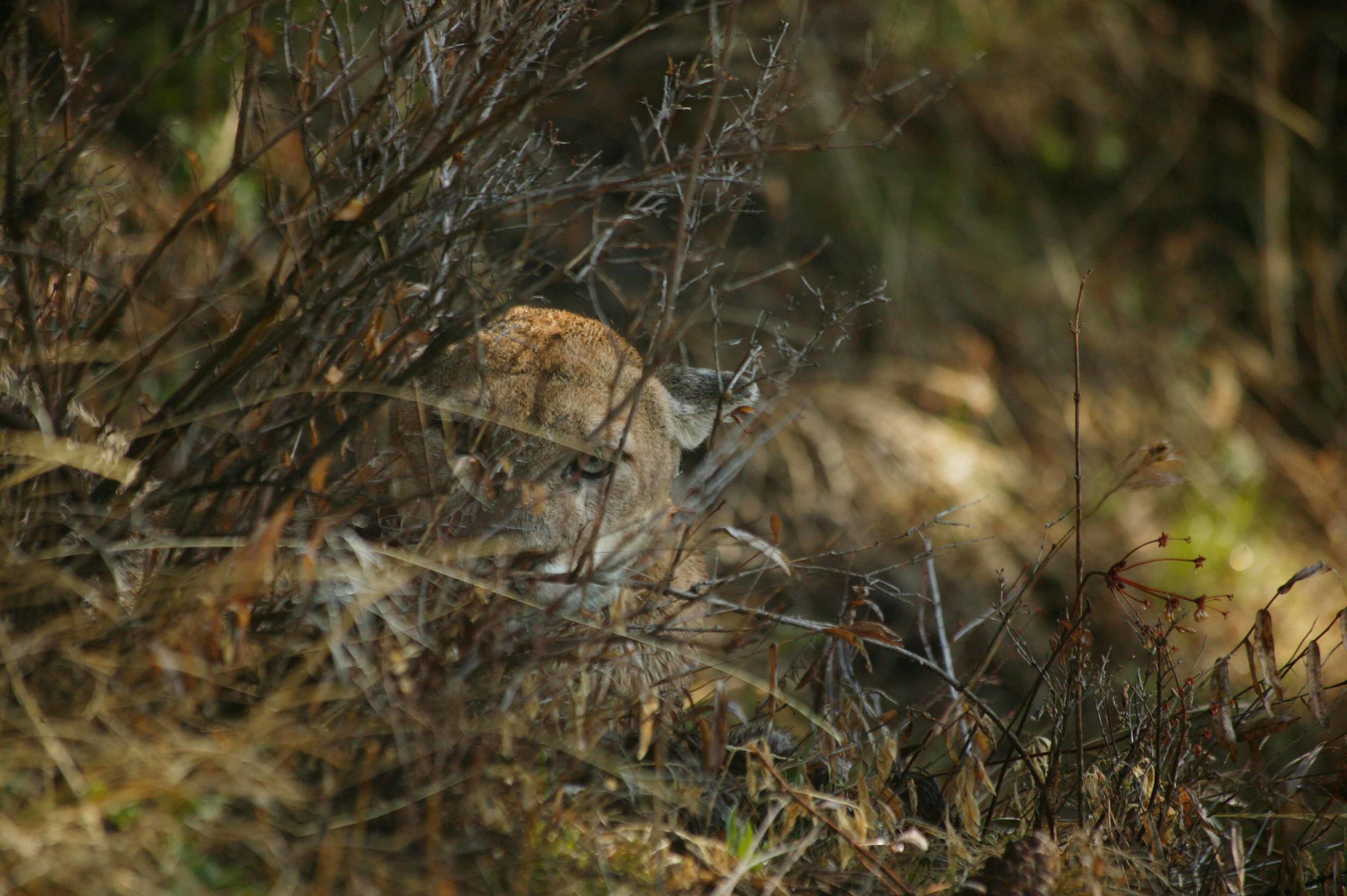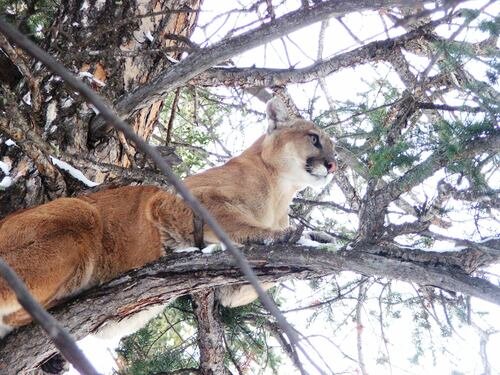Teton Cougar Project
Cougars are difficult to study due to their elusive nature, and the fact that they reside in vast rugged terrain at low densities. Human values toward cougars are diverse. They invoke feelings of awe and wonder to feelings of fear.
The TCP contributed greatly to the body of scientific information about cougars including insights into demographics, habitat use, and an understanding of predator-prey dynamics to clarify responses of these resident carnivores following wolf re-introduction in Yellowstone National Park and Idaho in 1995-1996. The Teton Cougar Project (2000-2012) captured and radio-collared more than 80 individual cougars. We utilized VHF radio collars and GPS collars to track cougar movements, locate potential predation sites, identify cougar dens, and to monitor kittens. We assessed individuals’ home ranges, territories, predation rates, and a shift in cougar predation habits as wolf presence increased following the reintroduction of wolves in Yellowstone National Park. The approximately 2,300 km2 study area extends from the town of Jackson, WY, to the northern boundary of the Grand Teton National Park. The entire region contains an estimated 12-14 resident, adult cougars.
Carnivores in the southern Greater Yellowstone Ecosystem are comprised of cougars, wolves, black bears and grizzly bears. The region also contains one of the highest concentrations of elk in North America. Following the extirpation of wolves in Yellowstone, cougars presumably extended their hunting niche to include those areas once occupied by their competitor, wolves. However, after the reintroduction of wolves into Yellowstone National Park and Idaho, wolves recolonized their historic range and cougars presumably adjusted by returning to their former range. We found that while cougars and wolves overlap in areas of use and prey upon similar species, cougars hunted in the higher elevations with forested cover while wolves hunted the lower elevations and on more open terrain (Woodruff et al. 2006).
Over the course of our study we observed what appeared to be an increase in the ratio of mule deer to elk kills (composition). To investigate these observations, we looked at potential wolf effects at both a population level and the landscape level, during summer and winter months. While elk were still cougars’ primary prey species, we looked at variation in the habitat characteristics and prey composition at predation sites in response to increased wolf proximity and numbers. Utilizing predation site characteristics (slope, aspect, elevation, ruggedness, and canopy cover) and specified criteria for determining cougar predation at kill sites, we found evidence supporting that cougar predation sites occurred at higher elevation and more north facing slopes during summer, and in more rugged areas during winter. We also found evidence that the probability of encountering a mule deer versus an elk at cougar predation sites increased in association with increasing wolf presence (Bartnick et al. 2013).
In additional investigations, we found that the success of dispersing individuals (more commonly young males in search of new territories) is influenced by habitat features. Comparing our study area with two others, we examined habitat use areas for dispersing cougars. In all three studies, cougars preferred habitats similar to those of the residents: rugged forested areas with ample access to prey, and they typically avoided development. Identifying these important habitat use areas helps to define connectivity corridors, which is important for ongoing conservation efforts (Newby et al. 2012).
As one of the most field-intensive projects in the west (monitoring 7 days per week for 12 years), we also documented several cases of previously undocumented cougar behavior. It was assumed previously that cougars were primarily solitary, however, we documented that on occasions cougars can be more social. We found instances of cougar family groups converging to hunt and feed together and cases of orphaned kittens apparently adopted into other cougar families.
In 2010-2011, Craighead Beringia South’s TCP team hosted filmmakers and collaborated with National Geographic Television for the creation of a one-hour documentary about cougars that culminated in the film American Cougar.
Publications
Disturbance type and species life history predict mammal responses to humans. (2021). Suraci, J. P., Gaynor, K. M., Allen, M. L., Alexander, P., Brashares, J. S., Cendejas‐Zarelli, S., ... & Wilmers, C. C. Global Change Biology, 27(16), 3718-3731.
Reintroduced wolves and hunting limit the abundance of subordinate apex predator in a multi-use landscape. (2020). Elbroch, L. M., Ferguson, J., Quigley, H., Craighead, D., Thompson, D., Wittmer, H. U. Biology, Medicine Proceedings of the Royal Society B.
Multiple anthropogenic interventions drive puma survival following wolf recovery in the Greater Yellowstone Ecosystem. 2018. L. Mark Elbroch, Lucile Marescot, Howard Quigley, Derek Craighead, Heiko U. Wittmer. Ecology and Evolution DOI: 10.1002/ece3.4264.
Comparing conventional and noninvasive monitoring techniques for assessing cougar population size in the southern Greater Yellowstone Ecosystem. (2016). Alexander, Peter D. Utah State University.
Food habits and Predation Dynamics of Cougar in Jackson Hole, Wyoming. Smith, Boone. ( ). Unpublished. University of Utah.
Spatial associations in a solitary predator: using genetic tools and GPS technology to assess cougar social organization in the Southern Yellowstone Ecosystem. (2015). Elbroch, L. M., Quigley, H. B., Caragiulo, A. Acta Ethologica, 18, 127-136.
Spatial overlap in a solitary carnivore: support for the land-tenure, kinship, or resource dispersion hypotheses? (2015). Elbroch, L. M., Lendrum, P. E., Quigley, H., Cragiulo, A. Journal of Animal Ecology, 85(2), 487-496.
Cougar den site selection in the Southern Yellowstone Ecosystem. (2015). L.M. Elbroch, P.E. Lendrum, P. Alexander and H. Quigley. Mammal Research 60, 89-96.
Recolonizing wolves influence the realized niche of resident cougars. (2015). Elbroch, L. M., Lendrum, P. E., Newby, J., Quigley, H., Thompson, D. J. Zoological Studies, 54.
Apparent Adoption of Orphaned Cougars (Puma concolor) in Northwestern Wyoming. (2014). Bartnick, T. D., Cuthill, M., Craighead, D., Quigley, H. B. Western North American Naturalist, 74(1), 133-137.
The Greater Yellowstone Carnivore Studies, Past and Future. What Next? (2014). Hornocker, M., Craighead, D. Wild Field Monitor, 9-11.
Home range characteristics of a subordinate predator: selection for refugia or hunt opportunity? (2014). Lendrum, P. E., Elbroch, L. M., Quigley, H., Thompson, D., Jimenez, M., Craighead, D. Journal of Zoology, 294(1), 58-66.
Variation in cougar (Puma concolor) predation habits during wolf (Canis lupus) recovery in the southern Greater Yellowstone Ecosystem. (2013). Bartnick, T. D., Van Deelen, T. R., Quigley, H. B., Craighead, D. Canadian Journal of Zoology.
Human-caused mortality influences spatial population dynamics: Pumas in landscapes with varying mortality risks. (2013). Newby, J. R., Mills, L. S., Ruth, T. K., Pletscher, D. H., Mitchell, M. S., Quigley, H. B., Murphy, K. M., DeSimone, R. Biological Conservation, 159, 230-239.
Seasonal foraging ecology of non‐migratory cougars in a system with migrating prey. (2013). Elbroch, L. M., Lendrum, P., Newby, J., Quigley, H., & Craighead, D. PLoS One, 8, e83375.
The Teton Cougar Project: Cougar ecology and monitoring in the Southern Greater Yellowstone Ecosystem. (2012). Elbroch, M., Quigley, H., Craighead, D. CBS.
Puma Dispersal Ecology in the Central Rocky Mountains. (2011). Newby, Jesse Ray. The University of Montana.
Investigating Cougar Predation Habits in the Southern Greater Yellowstone Ecosystem. (2010). Bartnick, Travis D. University of Wisconsin, Madison, WI.
Characteristics of Wolf and Cougar Kill Sites in the Southern Yellowstone Ecosystem. (2006). Woodruff, Susannah. Prescott College.
Cougar Ecology and Cougar-Wolf Interactions in the Southern Greater Yellowstone Ecosystem - Teton Cougar Project. (2005). Jaffe, R., Quigley, H., Craighead, D. CBS.
Additional supplementary publication:
Effects of wolf and grizzly bear recovery on cougars in a multi-use system. (2021). Jen Feltner. University of Montana.
Cougar Survival and Source-Sink Structure on Greater Yellowstone’s Northern Range. (2011). Toni K. Ruth, Mark A. Haroldson, Kerry M. Murphy, Polly C. Buotte, Maurice G. Hornocker, Howard B. Quigley. The Journal of Wildlife Management 75(6), 1381-1398.
Comparing ground telemetry and global positioning system methods to determine cougar kill rates. (2010). Ruth, T.K., Buotte, P.C., and H.B. Quigley. Journal of Wildlife Managements, 74, 1122-1133.
A technique for non-invasively detecting stress response in cougars. (2004). Bonier, F., Quigley, H., Austen, S. N. Wildlife Society Bulletin, 23(3), 711-717.
Assessing differential prey selection patterns between two sympatric large carnivores. (2003). Jason S. Husseman, Dennis L. Murray, Gary Power, Curt Mack, C. R. Wenger and Howard Quigley. Oikos, 101(3), 591-601.
Large-Carnivore Response to Recreational Big-Game Hunting along the Yellowstone National Park and Absaroka-Beartooth Wilderness Boundary. (2003). Toni K. Ruth, Douglas W. Smith, Mark A Haroldson, Polly C. Buotte, Charles C. Schwartz, Howard B. Quigley, Steve Cherry, Kerry M. Murphy, Dan Tyers, Kevin Frey, Wildlife Society Bulletin, 31(4), 1150-1161.

Cougars are an icon symbol of America's western wilderness areas.

When cougars are threatened they often take refuge in trees.

A young cougar, or kitten, will remain with its mother for a year or more before venturing off on its' own.

Cougars hunt by hiding and stalking their prey. In this study their diet was predominantly elk.

Cougars are shy and elusive animals and it is unusual to see one in the wild.

